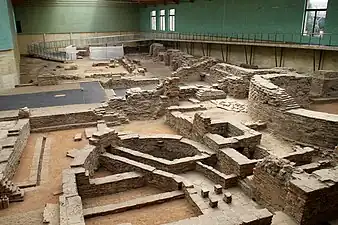Quintillus
Marcus Aurelius Claudius Quintillus (died 270) was a Roman emperor. He was a brother of Emperor Claudius Gothicus, whom he succeeded after Claudius' death in 270. Quintillus' claim to be emperor was challenged by Aurelian, who was proclaimed emperor by the legions he commanded. Quintillus' reign lasted no more than six months. Different sources report his cause of death as murder by his own soldiers, in battle with Aurelian, or by suicide.
| Quintillus | |||||||||
|---|---|---|---|---|---|---|---|---|---|
.jpg.webp) Aureus depicting Quintillus. Inscription reads IMP C M AVR QVINTILLVS AVG | |||||||||
| Roman emperor | |||||||||
| Reign | 270 (17–77 days) | ||||||||
| Predecessor | Claudius Gothicus | ||||||||
| Successor | Aurelian | ||||||||
| Born | 212 AD Sirmium, Pannonia Inferior (Sremska Mitrovica, Serbia) | ||||||||
| Died | 270 AD (aged 58) Aquileia, Italy | ||||||||
| Issue | 2 sons | ||||||||
| |||||||||
Early life
Marcus Aurelius Claudius Quintillus' exact birthplace is unknown. An Illyrian, he was likely born in Pannonia Inferior, as is indicated by his coinage.[2] Originating from a low-born family, Quintillus came to prominence with the accession of his brother Claudius Gothicus to the imperial throne in 268. Quintillus was possibly made Procurator of Sardinia during his brother's reign.
Reign of Quintillus
Quintillus was declared emperor either by the Senate or by his brother's soldiers upon the latter's death in 270. Eutropius reports Quintillus to have been elected by soldiers of the Roman army immediately following the death of his brother;[3] the choice was reportedly approved by the Roman Senate. Joannes Zonaras reports him elected by the Senate itself.[4] Records, however, agree that the legions which had followed Claudius in campaigning along the Danube were either unaware or disapproving of Quintillus' elevation. They instead elevated their current leader Aurelian as emperor.[5]
The few records of Quintillus' reign are contradictory. They disagree on the length of his reign, variously reported to have lasted 17 days (Jerome, Eutropius and Zonaras) or 77 days (Filocalus, Zosimus gives "a few months"). Modern scholars believe "17" to be a misreading of a larger number, as there is an abundance of coins produced during his reign.[5][6] Records also disagree on the cause of his death. The Historia Augusta reports him murdered by his own soldiers in reaction to his strict military discipline.[7] Jerome only reports that he was slain at Aquileia.[8] Joannes Zonaras reported Quintillus to have committed suicide by opening his veins and bleeding himself to death;[4] John of Antioch reports the suicide to have been assisted by a physician.[5] Claudius Salmasius noted that Dexippus recorded the death without stating causes.[9] All records, however, agree in placing the death at Aquileia. Quintillus was reportedly survived by his two sons.[10]
The Historia Augusta reports Claudius and Quintillus having another brother named Crispus and through him a niece, Claudia, who reportedly married Eutropius and was mother to Constantius Chlorus.[11] Some historians however suspect this account to be a genealogical fabrication to flatter Constantine I.[5]
Legacy

His reign was very short and he never managed to visit Rome as emperor. Surviving Roman records considered Quintillus a moderate and capable emperor.[3] He was seen as a champion of the Senate and thus compared to previous emperors Galba and Pertinax. All three were highly regarded by senatorial sources despite their failure to survive a full year of reign.[5] In his reign the priestly offices held by the emperor were separated and the image of the emperor as pontifex maximus was abandoned.[12]
See also
References
- Cooley, Alison E. (2012). The Cambridge Manual of Latin Epigraphy. Cambridge University Press. p. 500. ISBN 978-0-521-84026-2.
- Manders 2012, p. 258.
- Eutropius, IX:12.
- Zonaras, 12:26.
- Banchich 1999.
- Syvänne, Ilkka (2020). Aurelian and Probus. Pen and Sword. p. 65. ISBN 9781526767530.
- Historia Augusta, 12:5.
- Jerome, s.a. 271.
- Historia Augusta, 12:6.
- Historia Augusta, 13:9.
- Historia Augusta, 13:1.
- Manders 2012, p. 145.
Sources
Ancient sources
- Jerome (2005) [c. 380]. Chronicon. Translated by Roger Pearse.
- Aurelius Victor (2018) [c. 400]. Epitome de Caesaribus. Translated by Thomas M. Banchich.
- Eutropius (1853) [c. 380]. Breviarium ab urbe condita. Translated by John Selby Watson.
- "Live of Claudius". Historia Augusta. Translated by David Magie. 1913.
- Joannes Zonaras (2008) [c. 1120]. Epitome Historiarum. Translated by Basileos Nestor. Archived from the original on 21 May 2008.
- Zosimus (1814) [c. 500]. Nova Historia. Translated by J. Davis.
Secondary sources
- Manders, Erika (2012). Coining Images of Power: Patterns in the Representation of Roman Emperors on Imperial Coinage, A.D. 193-284. BRILL. ISBN 978-9004189706.
- Banchich, Thomas (1999). "Quintillus (270 A.D)". De Imperatoribus Romanis.
- Jones, A.H.M.; Martindale, J.R., Morris, J. (1971). Quintillus 1. The Prosopography of the Later Roman Empire I. Cambridge University Press, p. 759. ISBN 0-521-07233-6